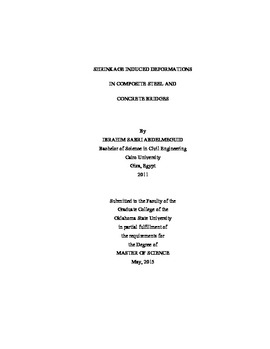| dc.contributor.advisor | Russell, Bruce W. | |
| dc.contributor.author | Abdelmeguid, Ibrahim Sabri | |
| dc.date.accessioned | 2016-09-29T18:30:21Z | |
| dc.date.available | 2016-09-29T18:30:21Z | |
| dc.date.issued | 2015-05-01 | |
| dc.identifier.uri | https://hdl.handle.net/11244/45127 | |
| dc.description.abstract | Concrete decks cast on steel bridge girders experience volume change beginning immediately after taking initial set. Volume changes in concrete result from temperature changes, creep or drying shrinkage of concrete. Shrinkage of the concrete occurs from a combination of hydration and evaporation as water is either consumed or pulled from the concrete. Resulting volume changes are the usual sources for cracking in concrete, serviceability problems and excessive deflections in deck slabs, sidewalks, driveways and other pavements, however they do not cause structural collapse alone. A poor prediction of such volumetric changes can be regarded as unimportant but it is important for some structures where serviceability and economic feasibility are needed. Recently, some Oklahoma bridges have been rehabilitated by casting new concrete decks atop existing steel girders. Some of these bridges experienced excessive downward deflections soon after construction was completed. Our research shows that concrete strains caused by drying shrinkage may account for some of these mid-span deflections. In our research, prototype beams were constructed from steel girders made composite with concrete deck slabs. These beams were monitored for temperature, concrete and steel strains and deflections. Results of the prototypes show downward deflections and concrete compressive strains consistent with the phenomenon of concrete shrinkage. Test results are compared to analytical iterative models that focus on concrete shrinkage. Models are based on ACI 209R-92 report shows methods for predicting creep, shrinkage and temperature effects in concrete structures. Three other numerical methods are compared in these reports and include the Bazant-Baweja B3 model, the CEB MC90-99 model and the GL2000 model. The four models are compared to one another and with the experimental results from the prototype beam constructed in lab. Some concrete properties were tested in the laboratory to use in the models. Despite the laboratory findings which connect concrete shrinkage to downward deflections of steel girder bridges, forensic investigations performed on real highway bridges that show the bridges were in a good condition and that shrinkage is not the likely cause of excessive deflections. | |
| dc.format | application/pdf | |
| dc.language | en_US | |
| dc.rights | Copyright is held by the author who has granted the Oklahoma State University Library the non-exclusive right to share this material in its institutional repository. Contact Digital Library Services at lib-dls@okstate.edu or 405-744-9161 for the permission policy on the use, reproduction or distribution of this material. | |
| dc.title | Shrinkage Induced Deformations in Composite Steel and Concrete Bridges | |
| dc.type | text | |
| dc.contributor.committeeMember | Ley, Tyler M. | |
| dc.contributor.committeeMember | Hartell, Julie | |
| osu.filename | AbdelMeguid_okstate_0664M_14082.pdf | |
| osu.accesstype | Open Access | |
| dc.description.department | Civil Engineering | |
| dc.type.genre | Thesis | |
